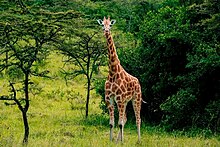| Giraffomorpha Temporal range: Early Miocene–Holocene PreꞒ Ꞓ O S D C P T J K Pg N | |
|---|---|

| |
| Reconstruction of Ampelomeryx ginsburgi | |

| |
| Giraffe (Giraffa sp.) | |
| Scientific classification | |
| Domain: | Eukaryota |
| Kingdom: | Animalia |
| Phylum: | Chordata |
| Class: | Mammalia |
| Order: | Artiodactyla |
| Infraorder: | Pecora |
| Clade: | Giraffomorpha Sánchez, Cantalapiedra, Ríos, Quiralte & Morales, 2015 |
| Superfamilies | |
Giraffomorpha is a clade of pecoran ruminants containing the superfamilies Palaeomerycoidea (Palaeomerycidae) and Giraffoidea (Giraffidae, Prolibytheriidae and Climacoceratidae), of which the giraffe and okapi of the Giraffidae are the only extant members of the once-diverse clade as a result of a decline in diversity after the Miocene as a result of declines in temperatures. The clade is defined by the presence of ossicones, suggesting that the feature was developed as a result of basal, related evolutions between the two superfamilies rather than as an instance of parallel evolution. Giraffomorpha is also characterized by a lack of articular fossettes (hollows) in metatarsal bones III-IV.
The position of the giraffomorphs Propalaeoryx of the Miocene of Africa and the insular Sardomeryx of the Miocene of Sardinia are not completely resolved but are recently suggested to be within the Palaeomerycoidea without being situated within the Palaeomerycidae family itself.
References
- ^ Sánchez, Israel M.; Cantalapiedra, Juan L.; Ríos, María; Quiralte, Victoria (2015). "Systematics and Evolution of the Miocene Three-Horned Palaeomerycid Ruminants (Mammalia, Cetartiodactyla)". PLOS ONE. 10 (12): e0143034. doi:10.1371/journal.pone.0143034. PMC 4668073. PMID 26630174.
- Xafis, Alexandros; Mayda, Serdar; Alçiçek, Mehmet Cihat; Kaya, Tanju; Halaçlar, Kazım; Grímsson, Friðgeir; Nagel, Doris (2020). "Large giraffids (Mammalia, Ruminantia) from the new late Miocene fossiliferous locality of Kemiklitepe-E (Western Anatolia, Turkey)". Palaeobiodiversity and Palaeoenvironment. 101 (3): 853–867. doi:10.1007/s12549-020-00433-4. PMC 8550776. PMID 34721707.
- Mennecart, Bastien; Dziomber, Laura; Aiglstorfer, Manuela; Bibi, Faysal; DeMiguel, Daniel; Fujita, Masaki; Kubo, Mugino O.; Laurens, Flavie; Meng, Jin; Métais, Grégoire; Müller, Bert; Rios, Maria; Rössner, Gertrud E.; Sánchez, Israel M.; Schulz, Georg; Wang, Shiqi; Costeur, Loïc (2022). "Ruminant inner ear shape records 35 million years of neutral evolution". Nature Communications. 13 (7222). doi:10.1038/s41467-022-34656-0. hdl:10362/151348.
- Mennecart, Bastien; Zoboli, Daniel; Costeur, Loïc; Pillola, Gian Luigi (2018). "On the systematic position of the oldest insular ruminant Sardomeryx oschiriensis (Mammalia, Ruminantia) and the early evolution of the Giraffomorpha". Journal of Systematic Palaeontology. 17 (8): 691–704. doi:10.1080/14772019.2018.1472145.
- Sánchez, Israel M.; Morales, Jorge; Cantalapiedra, Juan L.; Quiralte, Victoria; Pickford, Martin (2019). "Propalaeoryx Stromer 1926 (Ruminantia, Pecora, Giraffomorpha) revisited: systematics and phylogeny of an African palaeomerycoid". Communications of the Geological Survey of Namibia. 19: 123–131.
 | This prehistoric even-toed ungulate-related article is a stub. You can help Misplaced Pages by expanding it. |